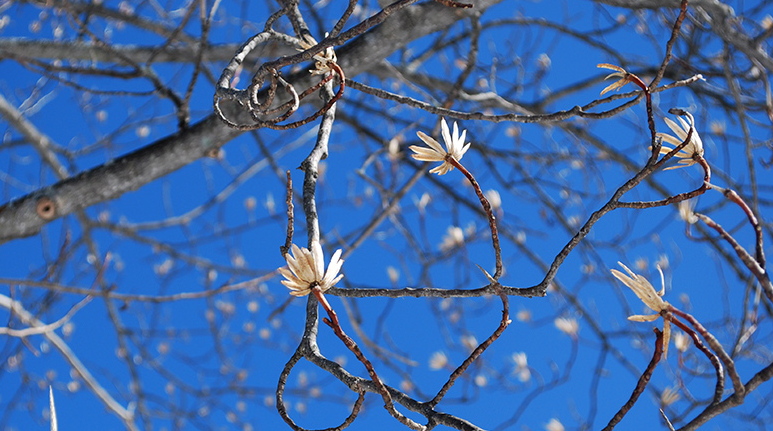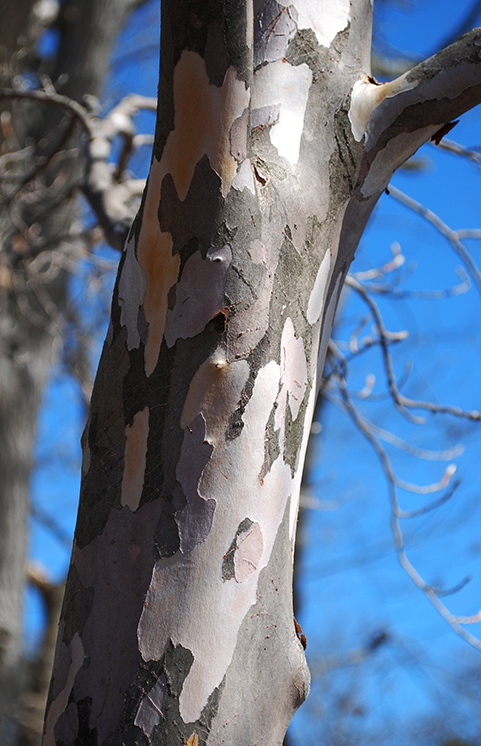Unrelenting winter kept our landscapes blanketed in snow for so long this year that even in late March, when I walked through Longfellow Arboretum in Portland’s Payson Park, there were few obvious signs of spring. But if you know what to look for, the still bare-branched trees spoke volumes and offered reassurance that spring would come.
“We’re all thinking spring, and we can’t wait for it,” said city arborist Jeff Tarling, who gamely braved below-freezing temperatures and a frigid, blustery wind to join me. He pointed to a stand of 75-feet-tall swamp white oaks. “From a tree’s perspective, it’s also waiting for spring, but not as impatiently as we are. We can go to Florida, but that oak is going to stay right here.”
I’d asked Tarling to tell me about the habits of trees. It may strike you as strange that they have habits at all. But Tarling explained that the term “habit” or sometimes “growth habit” actually refers to such characteristics as the trees’ overall form, crown shape, bark, direction of branching, thorns and seeds, all of which are easier to see in winter or early spring, before the trees have “leafed out,” as arborists phrase it. In late spring, the arboretum breaks out into bud. In summer it offers a leafy canopy, and in autumn a chance for citydwellers to leaf peep without taking a drive. But, as I learned on my walk, early spring has plenty of its own quieter pleasures.
“If you’re interested in the habits of trees,” Tarling continued, “this is the place to see them. The arboretum is really a collection of unique plants, including exotic trees from away, with an outline of natural woodland of red oak, white oak and maple.”
Starting from the Longfellow Arboretum sign, we strode across an icy patch to inspect a multi-trunked paperbark maple, which sports papery cinnamon-colored bark on its many upward-reaching trunks. Nearby, the form of a weeping cherry, with branches drooping from a central trunk, also invited observation. Tarling pointed to a swelling near the top of the trunk, where the branches had been grafted to it. Branches from excellent flower-producers are often grafted onto vigorous trunks of such ornamental trees, he said, to increase the likelihood of lots of blossoms. Nearby, a very bulbous knob of a weeping elm revealed an even more striking example of grafting.
It’s easy to distinguish such weeping trees by their many fine branches that droop to the ground. But the trees we looked at next had very different aspects – a tupelo with many-twigged branches reaching straight out horizontally, a shagbark hickory with branches bare of twigs reaching up, and a towering, densely branched, bullet-shaped upright English oak.
Tarling strolled on. He pointed out colorful bark, which looked like camouflage fabric, on a Korean Stewartia. He approached a broad-canopied yellow poplar, sporting forms so flowerlike it seemed to be blooming in sub-zero temperatures. Could that be? “Those are actually winged samaras, or clusters of seeds,” he explained.
Throughout the arboretum, the tips of tree branches are responding to light, he said. Humans may idly notice the lengthening days because it’s light out when they drive home from work, but for trees, which require sunshine for photosynthesis, these longer days are critically important.
Tarling, who is responsible for the trees in all of Portland’s public spaces, said he feels fortunate that the city was not struck by the December ice storm that damaged trees elsewhere in Maine. Winter’s steady, lingering cold this year – much as it tried the patience of winter-weary humans – was actually less challenging to trees than major temperature fluctuations would have been or warm days in early spring followed by a late-season cold snap, which can cause branches to break.
As we finished our walk, Tarling agreed that an early spring walk through the “living catalog” of the Longfellow Arboretum can open the eyes to the beauty of bare trees. That said, he encouraged visitors to come in all seasons.
Contact Rosemary Herbert at:rherbert@mainetoday.com
Send questions/comments to the editors.




Success. Please wait for the page to reload. If the page does not reload within 5 seconds, please refresh the page.
Enter your email and password to access comments.
Hi, to comment on stories you must . This profile is in addition to your subscription and website login.
Already have a commenting profile? .
Invalid username/password.
Please check your email to confirm and complete your registration.
Only subscribers are eligible to post comments. Please subscribe or login first for digital access. Here’s why.
Use the form below to reset your password. When you've submitted your account email, we will send an email with a reset code.